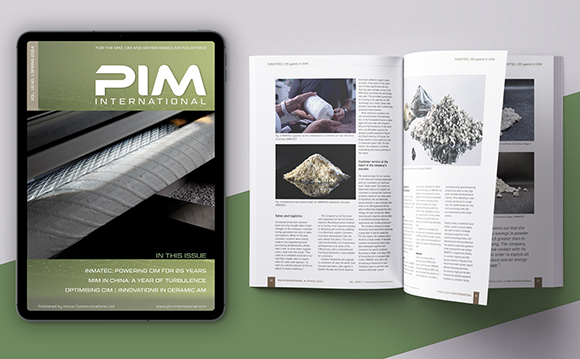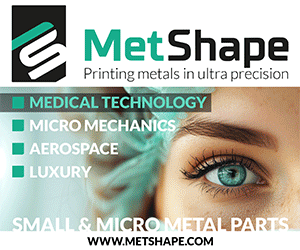Review of surgical tools and medical devices produced by Metal Injection Moulding published
August 5, 2020
Metal Injection Moulding has, over the past thirty years, achieved considerable success in the production of intricate components for a broad range of surgical devices, orthopaedic implants and other biomedical products made from a variety of biocompatible metal powders. A comprehensive review of MIM technology in the medical sector by A Dehghan-Manshadi, P Yu, M Dargusch, D StJohn, and M Qian, has been published in Powder Technology, Vol. 364, (2020), pp 189–204.
The review begins by providing an overview of MIM technology, such as feedstock preparation, injection moulding, debinding and sintering. This is followed by the latest trends for different metallic biomaterials processed by MIM, including stainless steels, titanium alloys, cobalt-chrome, iron and magnesium alloys, and the development of a selection of applications.
Just one of the many examples given by the authors is an intricate biomedical MIM part, which is used in a bone tissue engineering scaffold made to mimic the porous and permeable hierarchical architecture of the human bone and also to provide tissue support in-vivo through the porous MIM titanium structure. Such artificial bone scaffolds can be produced by MIM using a temporary space holder to achieve controlled porosity fraction and high pore interconnectivity.
The authors state that, thanks to their high sintered density, most MIM-produced biomaterials have static properties comparable to those made by conventional processes such as casting and forging. MIM has therefore found a number of applications in medical tools and instrument components, including minimally invasive surgery (MIS) tools having ever more complex shapes such as laparoscopic and endoscopic jaws, graspers, scissors, cutting and suturing tools. They state that, in many cases, manufacturing of such geometrically complex tools is no longer possible with conventional technologies, and MIM provides an important, if not the only, affordable pathway to their production. Such MIM parts are usually made from different grades of stainless steels to provide the required strength, hardness, corrosion resistance and ease of sterilisation. MIM is also used to produce general surgical tools such as scalpel handles, nippers, forceps and parts for instruments. As a further example, numerous surgical forceps are successfully produced by MIM and feature many fine structures that would be difficult to manufacture by other methods.
Other groups of medical components which can be made by MIM are the trauma plates, blades, screws and fixation devices used for fracture fixation in orthopaedic surgery, orthodontics, drug delivery equipment, hearing aid components and stent implants. Currently, stents of different materials can be made by MIM, including stainless steel and NiTi alloys, with both materials providing good biocompatibility and the required mechanical properties.
The area of orthodontics, such as extremely small and precision MIM stainless steel and Ti alloy brackets and hooks, was one of the early success stories for the MIM industry and these remain leading MIM products for the dental sector. Also, in the dental industry, MIM is used to produce ultrasonic endodontic and scaler tips from 316L stainless steel powders. However, whilst several studies have confirmed the potential for the MIM process to produce complex dental implants with micro details from stainless steel, titanium and magnesium alloys, the report states that mechanical property requirements have not always been met.
The same applies to other implants, which are subject to cyclic loading during their lifetime in the human body. Most MIM-produced biomaterials have static properties comparable to those produced by casting or forging, but their dynamic properties, especially fatigue strength, may be lower should small pores be present in the as-sintered microstructure. These pores can, of course, be eliminated by adding a Hot Isostatic Pressing (HIP)step after sintering to significantly improve fatigue properties. The authors stated that, whilst the use of MIM technology to produce medical implants is still largely under development, the future demand for implants with geometrically complex shapes significant progress in optimising the MIM process, and improved availability of powder materials such as fine spherical Ti alloy powders, is expected to result in more implants being produced by MIM.
The authors stated that the corrosion performance of MIM-produced biomaterials is still an area that needs further research. Systematic experimental data are still missing on the in-vitro and in-vivo corrosion performance of MIM fabricated implants and are needed to optimise the different aspects of the MIM process. This includes the development of fully biocompatible binder systems, optimum powder size and distribution, debinding conditions and sintering cycles. MIM technology has also shown potential to produce porous metal implants and the technology can be used as a cost-effective solution for the production of novel designs, including micro-sized and functionally graded devices, which may provide new pathways and solutions to current healthcare problems.
The authors concluded that the continuous healthy development of metal Additive Manufacturing (AM) is expected to further drive down the cost of the type of metal powders used by both MIM and AM industries. It is also concluded that the possibility of producing intricate and multifunctional injection moulding dies by AM for use in Metal Injection Moulding, plus lower powder prices, could lead to more affordable MIM parts.

















